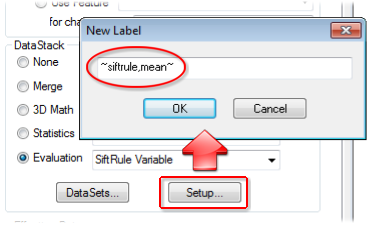Topic Contents: Hide
DataStacks are a method of combining DataSets to perform various calculations. DataStacks, once created, are a DataSet. Thus, DataStacks use most of the same properties as a DataSet, except for the Statistics tab, which has only some of the options available.
Setting the DataStack Values section of the DataStack Properties dialog will allow you to override any individual DataSet Spec Limits to use a single spec limit to the entire DataStack.
DataStacks can be used to perform various calculations on multiple DataSets. In the DataStack portion of the DataSource tab, there are four options available for combining your DataSets:
Once you have selected how you want to synchronize your DataSets, select DataSets... to select which DataSets you want to stack.
Merge allows you to combine all the DataSets of your DataStack in one of three ways: Append, Collate, or Subset.
Each DataSet will be added to the end of the other, in the order in which they are added to the DataStack.
Two or more DataSets are merged together row by row.
A set number of rows are counted from a Collated DataStack.
The selected 3D Math calculation is performed on the DataStack
Displays the sum of the values in each corresponding row of the DataSets in the DataStacks.
Displays the difference of the values of each corresponding row in the DataStack.
Displays the mean value of each corresponding row in the DataStack.
Displays the Hi value of each corresponding row in the DataStack.
Displays the Lo value of each corresponding row in the DataStack.
Displays the Range value of each corresponding row in the DataStack.
Displays the multiplied value of each corresponding row in the DataStack.
Displays the divided value of each corresponding row in the DataStack.
The selected Statistics calculations are applied to the entire DataStack.
The Multiply as Percentages operation is a type of Six Sigma calculation performed on the selected DataStack(s).
The selected Evaluation type will be done on the entire DataStack.
Count of how many features are in Tolerance.
Count of how many features are in Tolerance 2.
The Evaluation menu on the DataSet Properties DataSource tab is one way Measurement System Analysis Setup can be accessed. MSA Setup can also be accessed by opening the Feature Editor and double clicking the MSAs folder to open the Create or Edit MSA dialog, or by clicking the MSA button on the toolbar to open the MSA Wizard.
Using the DataSet Conformance Variables, you can determine whether the data in your DataSet conforms to the settings you are checking.
See the topic Polar Charts for information on the Miniball Analysis.
Resolves the Row variable entered in the Setup dialog for each row of every DataSet in the DataStack.
Resolves the DataSet variable entered in the Setup dialog for each DataSet in the DataStack. Each DataSet will be resolved to a single row in the DataStack, with one column containing the DataSet label and one column containing the value returned for the resolved DataSet variable.
This evaluation will process the defined SiftRule variable string against all Sift Rules within the stacked DataSets.

The resulting DataStack has a row for each DataSet in the stack. The label of the row is the label of the DataSet. There will be one column for each SiftRule. If more than one DataSet is stacked, then the number of columns will be determined by the DataSet with the most SiftRules defined. The label of the column is set to the label of the SiftRule.
|
Surf F/A |
Surf I/O |
Surf H/L |
Hole |
Dist |
Mid |
MuSiRu |
-0.220 |
|
+0.114 |
|
|
-0.153 |
If more than one DataSet is stacked, the column labels will only appear if all of the Sift Rules in that column have the same Sift Rule label. If the Sift Rule labels are different, the column header will remain empty.
|
Surf F/A |
Surf I/O |
Surf H/L |
Hole |
Dist |
|
q1000 |
-0.220 |
|
+0.114 |
|
|
-0.153 |
Legoman |
+0.142 |
|
|
|
|
+0.087 |
CornerMod |
|
-0.100 |
-0.107 |
|
|
|
Bullet |
-0.200 |
|
|
|
|
|
This evaluation summarizes stacked data based on the Sample Filters used. The Setup for this evaluation includes one or more Sample Filters (A-Z), one Feature Filter (optional), event triggers, values based on tolerance, and sorting.

The Feature Filter is optional. If a Feature Filter is not specified, then all 'columns', or Sample Filters, are accumulated.
The Summary Sample Filter DataStack Evaluation type is intended for use with the Summary Sample Filter Report builder. See the topic Summary Sample Filter Reports for information on how to create reports that use this DataStack evaluation.